Assembly of the CNC Machine has been a bit slow. Most recently I mount the NHK linear rails to the table frame for movement along the X-axis of the router, mounted the linear blocks which attach to the linear cars and tie them together, and mounted the uprights for the Y-axis and temporarily placed the Y-axis cross beams.
The photo below shows the progress so far from a few different angles. You can click on the photos to see larger versions.
The picture below shows the corner braces for the main table of the router. You’ve seen these if you’ve looked at the previous posts I’ve made about this project but it’s just a refresher.
I’ve also added some simple legs to the router. My plan right now is to mount the router to strong wooden table rather than spending the money to make the whole thing out of extruded aluminum. While I’m sure it would look great, it wouldn’t be that great on the budget. These stubby legs will be attached with angle aluminum to the sturdy table base.
The next photo shows the linear rail mounted to the the aluminum extrusion. There are two of these, one per each side of the main router table. The slides went in pretty easy using back plates I made out of some strips of steel. I believe the strips were 3/16ths thick. I used a centering punch through one of the rails and marked one of the backing plates for each hole. I then secured the backing plates together and drilled, then tapped them. They fit very easily into the T channel and once the rails are centered and secured with all the bolts in place they are very securely clamped into position. You can also see in this photo that the upper cross bars are cross-connected with 10mm x 50mm bolts.
Here is one of the aluminum blocks that I spent a lot of time sanding (on the backside) to mount up flush with the linear rail cars. You can see 4 bolts which attaches the block to one of the rail cars. The other 4 bolts are to the left and not in the picture. These plates now mount very flush to the linear rail cars and do not cause any kind of binding when tightened. It took a while to sand the block but it was well worth it. The front of the block is also sanded, but not as heavily.
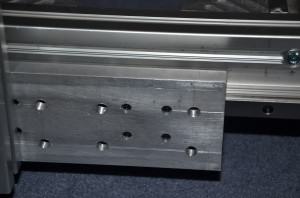 And you can see the block with the upright for Y-axis support in the picture below. There are supposed to be 6 bolts for the upright, and also a horizontal piece of extrusion which will support an angle brace, however I ran out of bolts to attach things at the moment and it’s easier to make adjustments for vertical if I don’t have the horizontal block attached yet.
And you can see the block with the upright for Y-axis support in the picture below. There are supposed to be 6 bolts for the upright, and also a horizontal piece of extrusion which will support an angle brace, however I ran out of bolts to attach things at the moment and it’s easier to make adjustments for vertical if I don’t have the horizontal block attached yet.
I used some 90 degree t-mount angle pieces from Bosch-Rexroth as end stops for the linear guides. They’ll have some rubber mounted to them to pad any accidental over-runs which cause the blocks to hit the stops. These also keep the rail cars from sliding off the tracks, so it’s a doubly good solution. As an added bonus these angle piece have a hole in the center so I should be able to mount the limit and home switches through those while keeping the switch housings from getting crushed if the axis runs to the end of the track.
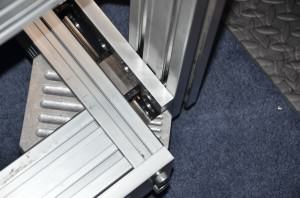
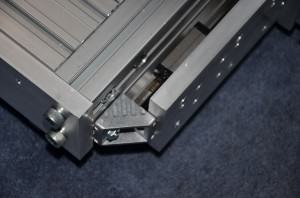 Below is another view of all the linear guide pieces together. They look pretty good and I’m happy with the results so far. There was one point of binding along the length of the track that resulted in a fair amount of resistance. I loosened up the 90 degree angle braces to the nearest cross beam, then tightened down the 10x50mm bolts a little more, this narrowed up the width of the base and pulled the rail in slightly and it now moves freely along the full length of the linear rail.
Below is another view of all the linear guide pieces together. They look pretty good and I’m happy with the results so far. There was one point of binding along the length of the track that resulted in a fair amount of resistance. I loosened up the 90 degree angle braces to the nearest cross beam, then tightened down the 10x50mm bolts a little more, this narrowed up the width of the base and pulled the rail in slightly and it now moves freely along the full length of the linear rail.
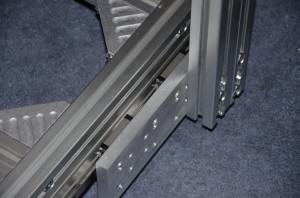 Below is just another perspective view of the assembly.
Below is just another perspective view of the assembly.
Previous: Y-axis Construction 1
Next: Great Progress!
Search CNC Posts

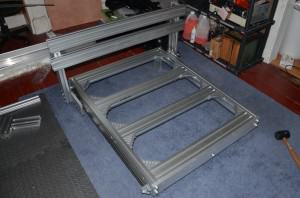
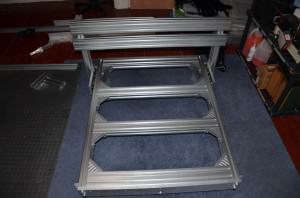
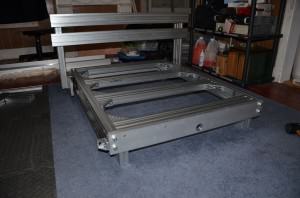
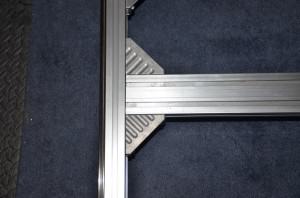
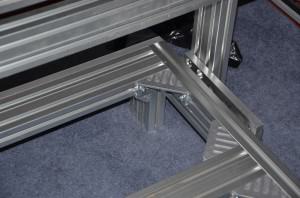
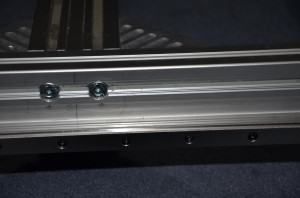
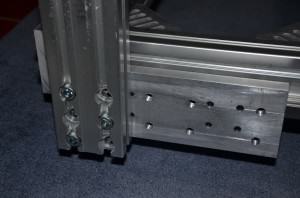
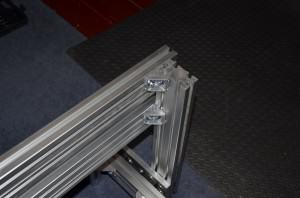
Part 9 : DIY CNC : Y-Axis Construction 2 1 Trackbacks / Pingbacks
Part 10 : DIY CNC : Great Progress | Jon's Hobbies Comment on Part 9 : DIY CNC : Y-Axis Construction 2 (October 10th, 2011 at 18:58)
[…] I’ve made some good progress with the DIY Router project this last weekend. In my last update on May 4, 2011 you could see that I was working on getting the uprights […]
Leave a reply to Part 9 : DIY CNC : Y-Axis Construction 2